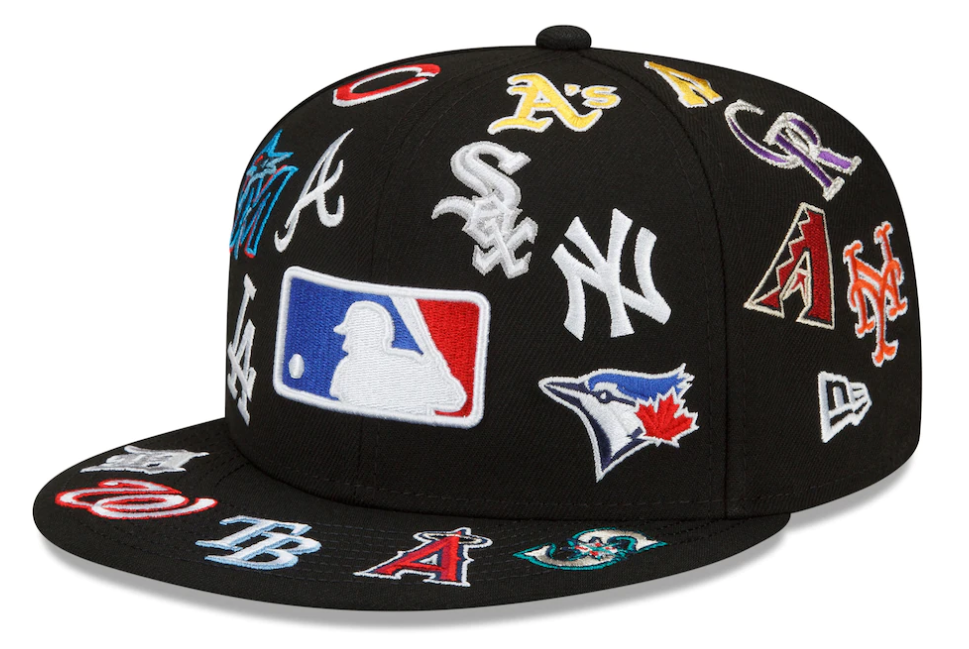
One of the criticisms you’ll hear about baseball if you hang out with people who constantly complain about baseball: There aren’t enough ways to build a team. It’s true on an individual level, where through the magic of video scouting and travel teams, batting swings have become identical; irregular deliveries have been weeded out and their owners banished or forced into hiding; and every hitter even closes their eyes in the same way in the same moment before they try to pull the ball to the same spot 425 feet away, eight rows deep into the bleachers. On a team level, the Kansas City Royals and their outdated “make contact and run” philosophy has been debunked, as did their belief that you didn’t have to store six years’ worth of draft picks in a walk-in cooler before springing them all on the league at the same time, in a frenzied dash to apply their talents to the postseason before they magically gained the ability to ask for money.
The result of all this homogeneity is that you have a bunch of good teams, who have figured it out, and a bunch of bad teams, who claim they’ve figured it out but have no way to prove that theory true yet. Fans of the latter have learned to give up on nebulous trifles like “hope” and instead sink their time and emotions into the baseball equivalent of worldbuilding.
It feels like such a waste to have all these perfectly able-bodied baseball players stuck losing baseball games all year, like the Europeans tossing their poets into the trenches for the sake of some mud and bragging rights in the Great War. We can’t save those poor souls, but we can capitalize on their relative tragic situations by engaging in a little thought exercise. The project: to figure out exactly how many bad baseball teams it takes to make a good baseball team, by simply grafting them together like some sort of hideous B-movie monstrosity.
We’ll start at the bottom, with your 2023 Washington Nationals, a team projected by PECOTA to lose 100 games. Then we’ll work our way up the ladder, adding another team, and then another team, to see how long and how large of a pool it takes to cross into competency and, perhaps excellence.
But first, the fine print: Look. This is dumb, okay? I’m going to need you to accept that this is dumb. I’m going to use our projections and depth charts to calculate what feels, at a very quick glance, like a complete roster. I will only play people at positions we project them to play, and I will only allot them the amount of playing time that we assign them to work in the real 2023 season. What I will not do is worry terribly about platoon issues, or bench coverage, or whether any of the new teammates would murder another by drowning them in the clubhouse jacuzzi. We’re just going off talent here. If you’re going to let a car go into space in Fast 9, we can let this go. It’s better for you, and it’s better for me.
OK, back to the work. The Nationals:
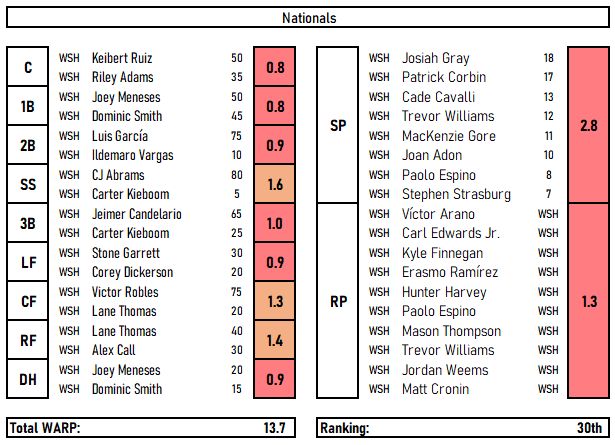
Are bad. My god, they’re so bad. A couple notes here: I’m only showing the top two contributors at each position, because data visualization is an art form, but for the WARP totals we’re drawing 100% playing time off the rosters. Shading, like in the the team previews, is based on a percentile scale, by 20s, with dark green being among the top fifth of the league, and pink/red the bottom fifth. (New additions are shaded in blue.)
So let’s start by folding in one Oakland Athletics baseball club.
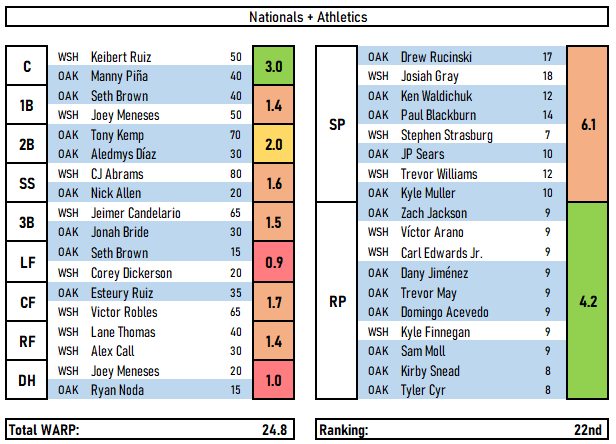
Not a bad start. It turns out the A’s are a pretty convenient base for this exercise, because they can’t quite tank the way other teams do, and thus have a bunch of almost-competent players to serve as roster spackling. Nowhere is that more obvious than at catcher, where the optimism for the highly-regarded Ruiz (1.7 WARP) was offset by the projection for backup Riley Adams (-0.9 WARP). Sub in Manny Piña and you suddenly have one of the better backstop combinations in the league.
We have Tony Kemp splitting time 50-50 between second and left, but with Luis García the alternative, I made the choice to put him at the keystone despite the other spot being kind of a black hole as well.
Finally, this experiment reveals just how expansive bullpens are, and just how few good pitchers there are to fill them. To put it another way: 73% of Washington’s relief innings are assigned to pitchers worth 0.1 WARP or less. Just by having two teams’ worth of competent relievers, we already have a bullpen that’s worth more combined than they are separately (1.3 for WSH and 2.1 for OAK), just by pruning, the sub-replacement guys on both rosters.
Some of that reliever talent is getting wasted in low-leverage situations, of course, so a 22nd WARP ranking probably wouldn’t translate to the 22nd-best record. But we’re making progress. Let’s now add the aforementioned Kansas City Royals.

The Royals, unlike the A’s, have clearly embraced the true spirit of the tank, because they have only a few additions to offer, and none of them fitting the Mutant Club’s weakest position, the outfield. Pasquantino and Perez provide some sluggers the team was sorely lacking, while we’ve shoved phenom Witt over to third base full time, absolutely because of our own team’s needs and not because he probably belonged there the whole time. Singer gets us one starter above the level of Oakland’s pitch-to-contact army, while we finally get a “real” closer to lead a bullpen that is already tied with the Rays for the best pen, in terms of WARP, in all of baseball.
This team is still going to struggle to score some runs, or really hit that many balls out of the infield except the two-through-five slots in the lineup. But we’re already hovering near a .500 team, tied in total WARP with the Texas Rangers. Next, we’ll splice in some Colorado Rockies:
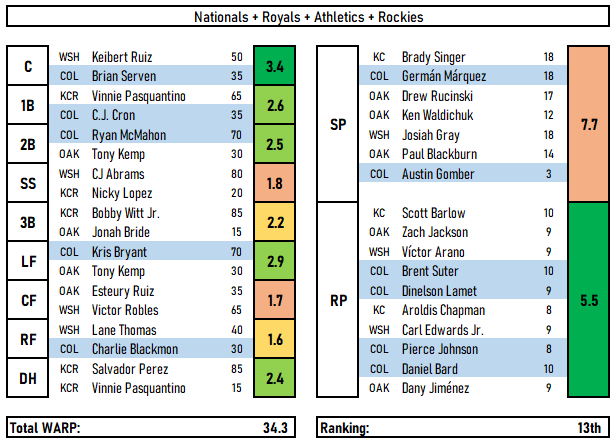
Combining four bad teams, we finally have the makings of a winning ballclub. Center field remains a glorified pitcher in the nine-hole, and the rotation remains weak. But the team gets its first real star in the form of Kris Bryant, who we project to… play in left field 70% of the time next year? Really? Huh. OK, something to root for. Charlie Blackmon finally breaks the Nats’ stranglehold on right field, while McMahon’s new old job at second base allows Tony Kemp to go back to his utility ways backing up two positions.
The bullpen also gets a boost, being a surprising strength for Dick Monfort’s crew, although note that four upgrades at the position result in a net gain of only 0.3 WARP. Just as it’s vital to clear out all those negative-value relievers, once they’re gone, it’s hard to make further progress. Relievers who provide 0.4 or so WARP are great, but not uncommon; the elites are rare.
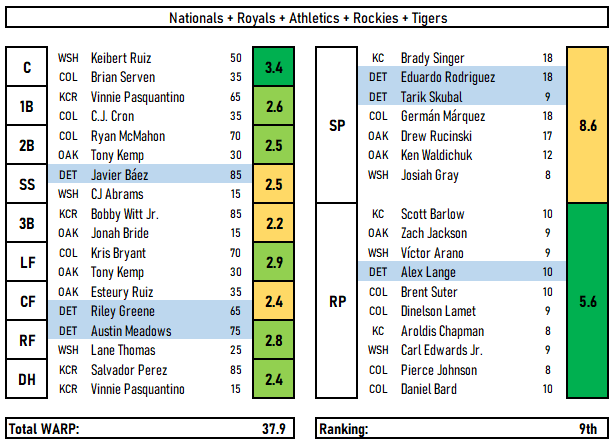
Only six additions now, as it gets a little tougher to make room for new players, but in many cases the upgrades were sorely needed. Riley Greene finally bumps Victor Robles off the roster, though PECOTA loves Esteury Ruiz and prefers him to the big-name prospect on a per-PA basis. Austin Meadows locks down right, while Javier Báez similarly provides an instant 0.7 WARP to the shortstop position. Eduardo Rodriguez and Tarik Skubal, when available, iron out the rotation, so that our Athletics starters are now mainly depth, as they should be.
It took five teams, but we now have a roster with zero holes, giving them better-than-even playoff odds. That said, they’re not particularly well-built for said playoffs, where a lack of top-line starters or dominant relievers would leave them at a major disadvantage against a more lopsided roster playing for today and not tomorrow. We have to keep going.
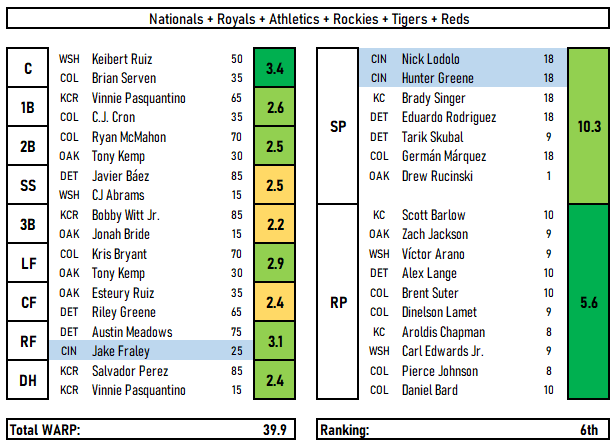
Time to add some Reds. That’ll… huh. PECOTA’s really quoting 68 wins on this team? The Reds are kind of the slightly better (or at least slightly less stripped-down) A’s roster, with aging but not exiled stars. They do give us two new aces atop the rotation in Lodolo (2.5 WARP) and Greene (1.8 WARP), bumping Oakland’s starters off almost entirely. That alone gives us a couple more wins, which is good, because they are literally alone. One more team.
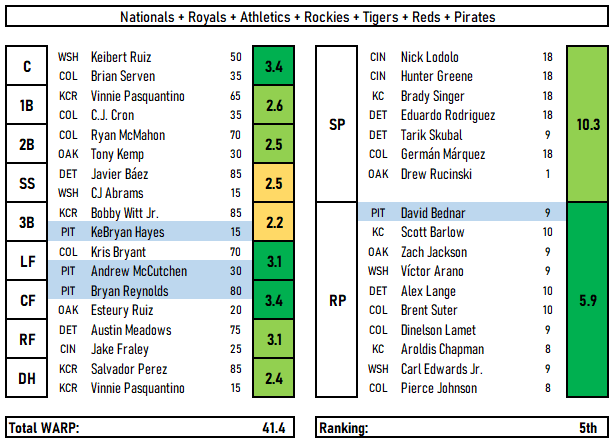
Seven teams. We’ve now combined a full quarter of the league, and we’re still half a win shy of a Dodgers team that is trying its damnedest to make itself worse. Ke’Bryan Hayes is actually almost a wash with Jonah Bride, which is certainly damning of someone or something, but he makes the team look better. PECOTA really likes McCutchen, but he too is a sliver of an upgrade over Kemp, who’s still around to back up second. And then there’s Brian Reynolds, who finally completes the outfield as a collection of true stars.
It’s a very good team, and it’s an extremely fun team—imagine getting to watch Ruiz, Báez, Witt, Hayes, Bryant, Reynolds in the same lineup—and it’s so close to being great. And over 162 games, it probably would be great; the talent level of its backups would allow the Mutant Team to brush off nearly any major injury. The depth of the bullpen would allow the team to go max effort through multiple playoff series, and even the weak spots in the lineup could easily outproduce their projections. All at the low, low price of $667.2 million dollars, with some sunk cost in there.
So there you go. I think we learned something today: That if we set apart our differences, ignore the colors on our game-used jerseys, we can you know what never mind let’s just keep going. One more. One more. ONE MORE.
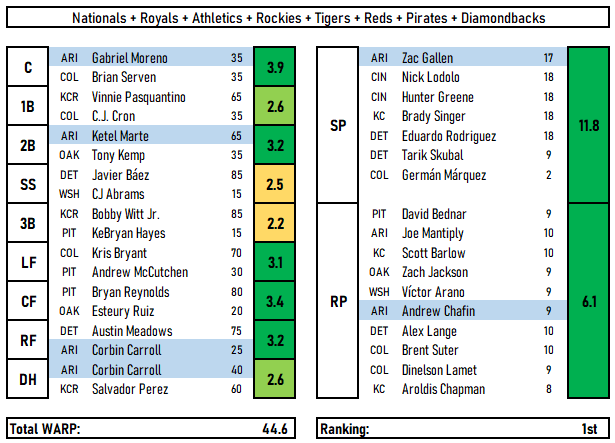
There you go. We did it. Sure, the Diamondbacks aren’t even a bad team, but I don’t care. It took us eight 40-man rosters, but we stitched together the best team in baseball, and even managed to hang onto two Nationals in the process. I’m proud of them. I’m proud of all of us. If I had the power I would make this team sweep the Astros in the World Series, and then reverse time and make it happen again, and again, because clearly I have supernatural powers if we’re enacting this hypothetical timeline. OK, and I’d probably kick Chapman off for Daniel Bard, but you know what I mean.
In fact: I renounce all my previous fandoms. I’m riding with the Kanoakaricol Pirednatigs for life. The nice thing is knowing that New Era has probably already got their hat somewhere in one of their warehouses.
Thank you for reading
This is a free article. If you enjoyed it, consider subscribing to Baseball Prospectus. Subscriptions support ongoing public baseball research and analysis in an increasingly proprietary environment.
Subscribe now